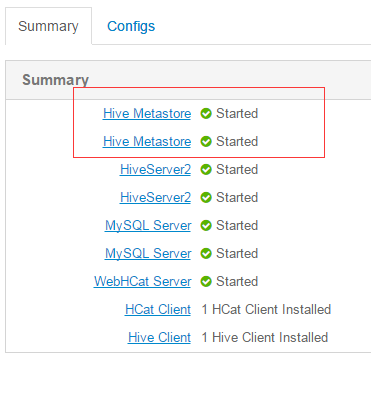刚开始我还没意识到MetaStore的作用,看了下生产环境的配置如下:

下面就来解释下系统是如何生成meta client的!
===========================================先来看几段代码!
public void createDatabase(Database db, boolean ifNotExist) throws AlreadyExistsException, HiveException {
try {
getMSC().createDatabase(db);
} catch (AlreadyExistsException e) {
if (!ifNotExist) {
throw e;
}
} catch (Exception e) {
throw new HiveException(e);
}
}
=========
private IMetaStoreClient getMSC() throws MetaException {
if (metaStoreClient == null) {
metaStoreClient = createMetaStoreClient();
}
return metaStoreClient;
}
=========
private IMetaStoreClient createMetaStoreClient() throws MetaException {
HiveMetaHookLoader hookLoader = new HiveMetaHookLoader() {
public HiveMetaHook getHook(org.apache.hadoop.hive.metastore.api.Table tbl) throws MetaException {
try {
if (tbl == null) {
return null;
}
HiveStorageHandler storageHandler = HiveUtils.getStorageHandler(conf,
tbl.getParameters().get(META_TABLE_STORAGE));
if (storageHandler == null) {
return null;
}
return storageHandler.getMetaHook();
} catch (HiveException ex) {
LOG.error(StringUtils.stringifyException(ex));
throw new MetaException("Failed to load storage handler: " + ex.getMessage());
}
}
};
return new HiveMetaStoreClient(conf, hookLoader);
}
=========
public HiveMetaStoreClient(HiveConf conf, HiveMetaHookLoader hookLoader)
throws MetaException {
this.hookLoader = hookLoader;
if (conf == null) {
conf = new HiveConf(HiveMetaStoreClient.class);
}
this.conf = conf;
localMetaStore = conf.getBoolVar(ConfVars.METASTORE_MODE);
if (localMetaStore) {
// instantiate the metastore server handler directly instead of connecting
// through the network
client = new HiveMetaStore.HMSHandler("hive client", conf);
isConnected = true;
return;
}
// get the number retries
retries = HiveConf.getIntVar(conf, HiveConf.ConfVars.METASTORETHRIFTRETRIES);
retryDelaySeconds = conf.getIntVar(ConfVars.METASTORE_CLIENT_CONNECT_RETRY_DELAY);
// user wants file store based configuration
if (conf.getVar(HiveConf.ConfVars.METASTOREURIS) != null) {
String metastoreUrisString[] = conf.getVar(
HiveConf.ConfVars.METASTOREURIS).split(",");
metastoreUris = new URI[metastoreUrisString.length];
try {
int i = 0;
for (String s : metastoreUrisString) {
URI tmpUri = new URI(s);
if (tmpUri.getScheme() == null) {
throw new IllegalArgumentException("URI: " + s
+ " does not have a scheme");
}
metastoreUris[i++] = tmpUri;
}
} catch (IllegalArgumentException e) {
throw (e);
} catch (Exception e) {
MetaStoreUtils.logAndThrowMetaException(e);
}
} else if (conf.getVar(HiveConf.ConfVars.METASTOREDIRECTORY) != null) {
metastoreUris = new URI[1];
try {
metastoreUris[0] = new URI(conf
.getVar(HiveConf.ConfVars.METASTOREDIRECTORY));
} catch (URISyntaxException e) {
MetaStoreUtils.logAndThrowMetaException(e);
}
} else {
LOG.error("NOT getting uris from conf");
throw new MetaException("MetaStoreURIs not found in conf file");
}
// finally open the store
open();
}
下面要认真分析下上面的这段代码,因为关联到一些参数的配置,对于理解生产环境的部署参数有帮助!
先看下面这段代码
localMetaStore = conf.getBoolVar(ConfVars.METASTORE_MODE);
if (localMetaStore) {
// instantiate the metastore server handler directly instead of
// connecting
// through the network
client = new HiveMetaStore.HMSHandler("hive client", conf);
isConnected = true;
return;
}
PS: ConfVars.METASTORE_MODE --- METASTORE_MODE("hive.metastore.local", true),
这里我的配置项是:


继续往下执行
// get the number retries
retries = HiveConf.getIntVar(conf, HiveConf.ConfVars.METASTORETHRIFTRETRIES);
retryDelaySeconds = conf.getIntVar(ConfVars.METASTORE_CLIENT_CONNECT_RETRY_DELAY);
这两个比较简单,
// Number of times to retry a connection to a Thrift metastore
// server
METASTORETHRIFTRETRIES("hive.metastore.connect.retries", 5),
// Number of seconds the client should wait between connection
// attempts
METASTORE_CLIENT_CONNECT_RETRY_DELAY("hive.metastore.client.connect.retry.delay", 1),
就不详细描述了!
======================================================================================
接下来看
if (conf.getVar(HiveConf.ConfVars.METASTOREURIS) != null) {
PS: METASTOREURIS("hive.metastore.uris", "")
那么我的配置是:

好,回到代码,有这么一行
String metastoreUrisString[] = conf.getVar(HiveConf.ConfVars.METASTOREURIS).split(",");
那么,你知道为啥生产环境的多个 thrift 服务器之间用都好分隔了吧!
-------------------------------------------------------------------------------------------------------------------------------------------
下面开始放到数组里
try {
int i = 0;
for (String s : metastoreUrisString) {
URI tmpUri = new URI(s);
if (tmpUri.getScheme() == null) {
throw new IllegalArgumentException("URI: " + s + " does not have a scheme");
}
metastoreUris[i++] = tmpUri;
}
} catch (IllegalArgumentException e) {
throw (e);
} catch (Exception e) {
MetaStoreUtils.logAndThrowMetaException(e);
}
所以不要忘记写上具体的scheme.
===继续
// finally open the store
open();
估计就是去连接meta server.---幸亏之前看过thrift源码,轻车熟路啊 :) thrift的源码写得比netty好懂!
突然想起来Hive就是facebook出品的, thrift也是facebook出品的,所以Hive使用Thrift也是理所当然的。
=============================================================好,我们继续跟踪open...
private void open() throws MetaException {
for (URI store : metastoreUris) {//一个一个遍历尝试
LOG.info("Trying to connect to metastore with URI " + store);
try {
openStore(store);
} catch (MetaException e) {
LOG.error("Unable to connect to metastore with URI " + store, e);
}
if (isConnected) {
break;
}
}
if (!isConnected) {
throw new MetaException("Could not connect to meta store using any of the URIs provided");
}
LOG.info("Connected to metastore.");
}
那么,我们进入openStore函数看看!具体代码不贴,点重点
-----------------------------------------------------------------------------------------
boolean useSasl = conf.getBoolVar(ConfVars.METASTORE_USE_THRIFT_SASL);
PS: METASTORE_USE_THRIFT_SASL( "hive.metastore.sasl.enabled", false)
默认不配置,为false
---------
transport = new TSocket(store.getHost(), store.getPort());---创建socket
((TSocket) transport).setTimeout(1000 * conf.getIntVar(ConfVars.METASTORE_CLIENT_SOCKET_TIMEOUT));
---------
client = new ThriftHiveMetastore.Client(new TBinaryProtocol(transport)); --- 创建一个client
然后就是去创建连接
for (int attempt = 0; !isConnected && attempt < retries; ++attempt) {
if (attempt > 0 && retryDelaySeconds > 0) {
try {
LOG.info("Waiting " + retryDelaySeconds + " seconds before next connection attempt.");
Thread.sleep(retryDelaySeconds * 1000);
} catch (InterruptedException ignore) {
}
}
try {
transport.open(); --- 这个时候就开始去连接MetaStore Server了。
isConnected = true;
} catch (TTransportException e) {
tte = e;
if (LOG.isDebugEnabled()) {
LOG.warn("Failed to connect to the MetaStore Server...", e);
} else {
// Don't print full exception trace if DEBUG is not on.
LOG.warn("Failed to connect to the MetaStore Server...");
}
}
}
--------------------
既然如此,我们接下来就去研究MetaStore Server!!!
启动metaStore server后
private void openStore(URI store) throws MetaException {
里面的
try {
//看到这里了
transport.open();
isConnected = true;
} catch (TTransportException e) {
生成完毕!






















 1139
1139

 被折叠的 条评论
为什么被折叠?
被折叠的 条评论
为什么被折叠?








